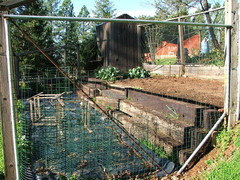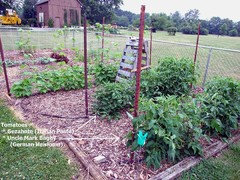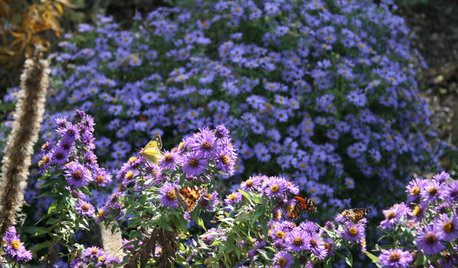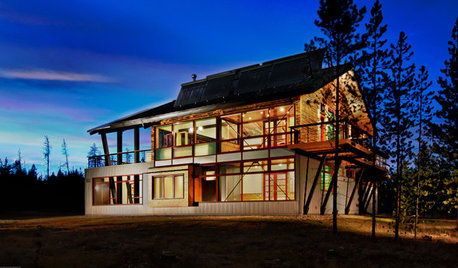No-Till Method?
Because of a sore back, I've decided to make two new large island beds in my front yard using the no-till method. I laid plastic over the grass this spring until the grass died. Then I pulled up the plastic and put thick layers of newspaper on the ground as a weed barrier. Lastly a mix of potting soil and topsoil on top. For each plant, I dug holes through the newspaper layer so the plants roots could go as deep as they need.
I'm wondering if this type of garden will succeed. My neighbors are watching me, and I'll sure be embarrassed if all dies!
Has anyone out there tried no-till and can you give me some tips?
Comments (29)
Sunny_Sky
Original Author21 years agoMy son came home from school yesterday saying that his science teacher said that Illinois farmers are going to be required to go to the no-till method in order to stop the erosion and depletion of our topsoil.
Related Professionals
Quincy Landscape Architects & Landscape Designers · Brooklyn Park Landscape Contractors · Dudley Landscape Contractors · Golden Landscape Contractors · Mission Bend Landscape Contractors · Santa Ana Landscape Contractors · Wentzville Landscape Contractors · Clermont Decks, Patios & Outdoor Enclosures · Draper Decks, Patios & Outdoor Enclosures · Lake Morton-Berrydale Decks, Patios & Outdoor Enclosures · Renton Decks, Patios & Outdoor Enclosures · Roseville Decks, Patios & Outdoor Enclosures · Framingham Siding & Exteriors · Independence Siding & Exteriors · Woodbridge Siding & Exteriorstwo_munkeys
21 years agoI've just used a similar method.....only I wasn't patient enough to wait for the grass to die. This wasn't for a garden bed though, I just got tired of mowing the lawn around three spruces I have in a triad. I simply laid thick layers of newspaper right over the sod, and topped with about 4" of mulch.
I hope this works. Has anyone tried this before?
shakaho
21 years agoIf this procedure isn't familiar to you, you should go to the Soil, compost and mulch forum. Many people will report their successes.
eaglesc_technowhacko
21 years agoyears back,there was a book no till gardening by Ruth Stout. I belive rodale press still has it. First try would be the local library
Sheila7863
21 years agoIt's called Lasagna Gardening!!! I've been doing it for four years now with HUGE success. I can no longer dig, so all new flowerbeds are done in this manner. You can layer ANY organic material (sand, manure, leaves, peat moss, grass clippings, kitchen veggie and fruit trimmings, (NO animal material) with layers of newspaper, white paper, cardboard boxes, etc. in between. I layer mine about 1 foot high. The key to success is to water it a LOT, soaking every layer as you put it down. You can then tear down through the layers with your hands, tuck the plants right in and tuck the layers back around them. Or you can toss seeds in. By the end of the summer it will all turn into about 4" of the prettiest dirt you ever saw with very few weeds!
The first year I tried this on two very small beds. The flowers in those two beds were the happiest and biggest in the whole yard!
Yes, Rodale still has the book and I believe you can get it at organicgardening.com.
Kay_H
21 years agoYour method should work fine so long as you put down a good thick mulch. Otherwise you and your sore back are going to be doing a lot of bending over to pull weeds. You can use grass clippings, straw, hay, woodchips, chopped leaves or whatever seems attractive to you.
I have tried the lasagna bed method as described by Sheila, but have found that it is really only useful if the grass is completely killed off before planting. Otherwise the grass will find a way to the sun via the holes you dug for the plants. Therefore, I only use the lasagna bed method for existing garden areas, new gardens that I will not plant into until next year or, like you have done, kill off the grass first.
As long as you have decent soil there, you don't need to stack a large variety of organic material. Anything that will block the light will kill off the sod and also improve the tilth of the soil.
Definately mulch. I mulch with whatever I have handy as it becomes available, but I find that a good thick mulch applied in the fall, after annuals have died and most pereniels are ready to be cut back really saves time and effort in the spring when weed seeds are germinating like gangbusters.
Kay.
breathe
21 years agoI just cut the grass very short, cover it with cardboard and wet it down, then cover with wood chips or leaves. I've only ever had grass/weeds come up at the edges where it meets a driveway or sidewalk. The reason that happened is because I couldn't make the mulch thick enough (2-3 inches) or it would have spilled all over the hard surface. I either just pull the few blades that manage to grow through or, if I'm feeling ambitious, dig a small trench around the edge and toss the strips in the middle of the bed before covering.
"Everyone's experience and situation is different."
kathryn_9b
21 years agoHere's an FAQ from the soil forum.
Here is a link that might be useful: No Till Gardening
Nelz
21 years ago3 years ago I planted potatotes the old fashioned way. Plant in a trench, hill up once filling trench, heal up again.
2 years ago I used straw for the 2nd (and a 3rd) hilling.
Last year I did not dig a trench first, but I hilled exclusively with straw.
This year, less work yet. Layed out 6-8 layers of newspaper throughout potato section. Wetted it down to prevent fly away. Placed seed spuds on top of paper at appropriate planting intervals, like a landscaper setting out plants and adjusting before digging. My neighbor wanted to know why I was laying out my seed potatoes to dry. He was shocked when I started covering them with 1 foot of straw. He thought it was going to be a huge chore to dig under all that straw to plant the potatoes.
I 'hilled' the 'taters with straw twice. They grew just fine. Stealing a few was easy, and I am storing clean potatoes this year, without cleaning them!
Actually it was a little late to plant them, and it was this quick way, or compost the seed potatoes.
I'll do it this way next year also!
Ken
PS. I haven't tilled since the garden was put in 4 years ago. Work amendments into beds in the fall (chopped straw, leaves and grass clippings mostly) and cover with straw for the winter. Some areas are cover cropped also.
Beta
21 years agoI have garden space 30x60 or so. It has been tilled, probably 2-3x over three years. It is clay, but I have been amending it as I go; still it needs more. Last year in our drought (zone 7), the pigweed took over. It was a disaster. I had planted in rows and found it very wasteful all round.
This year, I am planning short, raised beds. I have access to lots of dried cow manure and "spent" hay. Also, some chicken droppings. I am very interested in the NO TILL methods that I have read about here -- I envy you all that have that luscious soil.
Given the above, and using the no-till, layering, would someone please give me their "method"? That is, what layer goes first or second or third?? For example, On the clay soil, do I layer manure, then paper/cardboard/leaves, or vice versa, or does it matter?
I also planted clover as a cover crop between my corn rows. At what point does it need to be turned under, or is it turned under in No Till?
I plan to have a small truck stand this year with better produce than from last year.
I am reading Ruth Stout.
Thanks.
jimax1920
21 years agoSpeaking of Ruth Stout. Her method was using straw to mulch. She mulched with straw really deep. If grass or weeds showed their heads, she piled on more straw.
To plant she pulled the straw back to plant. As soon as the seeds came up she pulled the mulch back around the plant as it grew. She never added anything else to her soil. She is dead now, Rest her soul. I read her book back in the '60's. I'll join her before long.
westbeck35
21 years agoI have Ruth Stout's book. But I live in a place that has to have the mulch removed when the snow melts or the ground will not warm up enough to plant your seeds. I have changed to raised bed gardening and have found the same problem. I now mulch after the crops are in, leave it on all winter, remove the mulch to the compost pile in the spring and after the ground warms start over with new mulch.
zucchini
21 years agoI, too have Ruth Stout's book. Started using it in the early 70's..Moved to the city and forgot about it..Now back out in the country, found her book, and a book on Lasanga (sp) gardening..no till for me from now on. Did two as an experiment last summer...with newspaper,cardboard, leaves, compost, lots of coffee grinds, leaves, etc...planted in it within a month..worked great. zucchini
raptorfan
20 years agoI got a great book recommended on this website from our local library on the subject. It's called Lasagna Gardening by Patricia Lanza and it's really informative especially for new gardeners such as myself. I plan on using cardboard as a base rather than newspaper, and have started adding to my composter like crazy. I want to make a large island bed and don't want all the digging. Keeping my fingers crossed!
posy_pet
20 years agoI read Ruth Stouts book years ago also-she used mulch so she didn't have to till-used hay and straw and leaves too if I remember right and compost too.And I had good luck last year with lasagna gardening.Planted my tomatoes in new ground-didn't hardly get the grass killed.Did put compost in the holes and mulched with newspaper and grass clippings.They did great.Shredded leaves are great too to mulch with.Read the book How to garden without an aching back!Posy Pet
newinva
19 years agohelp!!! i tried this method, and i peeked under the newspaper, to find that my cover crops are still alive and well (after being covered for 2 weeeks with newspaper. what am i doing wrong???
wild4wildlife
19 years agoi tried the lasagne method and it was a disaster for me. i did it exactly as directed and within 3 months grass started to grow again. even thicker than before. it was aweful, my beautiful flowers were smothered by all the grass. i couldnt control it, but luckily we moved and i didnt have to care about it anymore. now im doing it the right way, total removal of sod and thick mulch. its breaking my husbands back lol but its the only way that works.
redblossom40
19 years agoWe don't till anymore.

This method has work for us for the last couple of years. Yes when the material comes off in the spring the soil under is loose and you sink in it.
When it comes time to plant we just hoe an spot and plant. We also try to place our leaves from our oak tree in before the material goes on.
Anyways it works for us and just a few weeds to pull after the material is remove and the sunshine warms the soil up.Tamara
jkirk3279
19 years ago"Yes when the material comes off in the spring the soil under is loose and you sink in it."
Cool. What material did you use? It looks like a rubberized fabric.
redblossom40
19 years agoJkrirk, we used landscaping material and in the small area we used black plastic. It save us about two days of pulling and tilting weeds. We started this about two years ago after I got tried of the clean up before planting, plus this keeps the bad bug population down. I recommend this to anybody who likes to get a head start on gardening.
Tamara
sugarhill
19 years agoI am still experimenting with my first lasagna bed, but so far it's working. Someone asked where to put the newspaper in the layers. The newspaper goes first - the bottom layer - next to the ground. I layered compost, peat moss, grass clippings, composted manure in two inch layers until I had 12 inches. Then I covered it and let it cook and settle a little for about 6 weeks. Then I planted in it. I didn't cut holes through the newspaper - the bed never settled more than a couple of inches so it is still about 10 inches high. So far everything I planted there is doing well. The soil it made is so easy to plant in that I can make the planting holes with my hands. The plants in this bed grow well. I'm pleased so far.
I have never looked to see if the newspaper has decomposed. I suppose after two years it has. I don't know if this has improved the soil underneath the raised bed. It is such damp clay - almost a gumbo - that I wanted to build on top of it rather than improve it. I have irises, herbs and geraniums planted in this bed and they are happy there. No weed seeds have sprouted, no grass has come through, so I am happy too.
meldy_nva
18 years agowild4wildlife - there seem to be 3 keys to succeeding with lasagna: 1st is to make the bottom layer thick enough (newspaper, cardboard, etc.) to be sure the weeds/grass cannot sprout through it -- 1/4" is the usual, but I go much higher over stuff like quckgrass, using 1/2" of sopping *wet* paper for the first layer. The 2nd key is to pile the layers up: a 12" high stack is about minimum, 15" to 18" tall is even better. And the 3rd key is to mulch the topmost layer heavily -- at least 2" of shredded leaves or bark. Otherwise, there isn't really only one right way... you just keep alternating layers of brown stuff, green stuff, with a sheet or two of newspaper and a sprinkle of soil or bloodmeal.
ajourni
18 years agoWill unfinished compost as a layer over the newspaper hurt the plants? I'm going to get some topsoil and potting soil, and maybe a bit of bagged compost, but I have TONS of unfinished compost and not a lot in the gardening budget. The compost is primarily used guinea pig bedding (pine chips), with some coffee grounds (thank you, Starbucks!), and kitchen scraps. And could I use the formentioned unfinished compost as a mulch for the top?
meldy_nva
18 years agoajourni- you can use the unfinished compost in layers, how thick for each layer depends on the stage of it's being finished. If it were mostly the pine chips, I'd call it a hard-brown and keep the layer to about an inch. Use a 1" to 2" layer of fresh green (grass mowings etc) for the alternate layers, with a couple sheets of wet newspaper between each layer. I like to sprinkle a bit of bloodmeal lightly over the brown and a heavy sprinkle of dirt over the green, just to encourage speedy conversion. That lasagna is a bit too basic for immediate use by plants, but you can make holes somewhat larger than the rootball, putting an inch of good soil at the bottom and packing good soil (1"+) around the transplant. By the time the roots grow through the good soil, they can make use of the nourishment in the partially composted layers. I find simple annuals and most of my vegs seem to like being "on top" of the lasagna, and don't mind the settling down.
I'm not sure about using the 'unfinished' as a mulch... but maybe okay, especially if it were chips and coffee grounds. Do the used chips have an odor that might attract roaming animals? You don't want stray dogs digging around looking for the guinea pig's nest. Personally, for the top layer, I'd rather use a couple inches of shredded leaves from the community recycling.
ajourni
18 years agoThanks for the info. I've never noticed it being bothered by animals, so maybe I'll give it a go and see what happens. I almost wish the dogs *would* dig through the compost pile...then it would get aerated and compost quicker!
tenajyebba
18 years agoI first read Ruth Stout many years ago and decided when I got out of the city and had a garden,that's the way I would do it. For my first organic graden in MO I had an acre,unfenced and got a lot of spoiled hay bales,the square kind with the string around them. The ground had not been tilled and I soon saw that tearing these bales into shreds was going to be really hard and long work. So being an experiemental psychologist(and impatient)I broke them off into "books"about a foot thick and layed them on the ground edge to edge. This was in the late fall. It rained and snowed on them all winter. In the spring I put my hands in the middle of each and kind of pulled a hole into it and dug down some with a tool and put in my peppers and tomato seedlings that I had started in containers. Potatos I put in by laying them on the top of the ground and covering them back klup again. The butternut and acorn squash I did the same and just put in the seeds instead. Same with peas and green beans. The lettuce I planted in a low very wet place by scratching the surface and putting seeds in along with marigold seeds. I forget how I did the Swiss chard and okra,but I think I did them in July with seeds. I never bothered watering,but it rained a lot that year. Once in awhile I would carry milk gallons of water to water young seedlings,but it was a longish walk and I didn't do it very often nor did they look thirsty to me very often. I had a huge yield. One big pickup truck full of squash. Dozens of canned tomatoes and 6 gallons of dried tomatoes. We ate every thing else. Oh I did dry a lot of peppers and bagged potatos and bartered them with the local health food store. But back to the no tilling part. Putting the mulch on in "bbok" form is the key. Once any weeds started to come up where the edges met,that edge got another "book" laid on it. (Oh I put corn seed between the tomatoes so the vines could be tied to the stalks.)If you put on "loose"mulch then you have weed problems. But the thickness of the pressed mulch suffocates the weeds. Also if you are tired of cutting grass plant dutch clover in the fall or late winter all over your yard. A hundred pounds will do a good sized yard. Then let the rains do the job on it. It comes up ahead of the grass(weeds here)and tends to inhibit the growth of the weeds. The flowers make your yard smell like perfume all the time and your dogs and cats(I did it for my German Shepard Josephine) love to lie in it. It grows about 10 inches at the most so you don't have to cut. If you have a drought you will have to water as the clover likes lots of water. The bees are happy too. Just DON'T CUT IT because that will allow the weeds to grow and crowd it out. Then you can start to think of little islands of flowers or whatever you want to plant in the clover. Read The One-Straw Revolution(somebody please reprint this book)and you will get more ideas like this.
jimmygfarm
9 years agoya'll should remember that Ruth Stout s garden was plowed for years before and only stopped cause the neighbors that did that for her couldn't get to it because he was to busy.
jukeboxblues
9 years agolast modified: 9 years ago2014 was my first year of deep mulch gardening and I will never go back. The very first season was a convincer, not only for the great produce but absolutely no weeding and I only watered twice.
I suggest you watch the Back to Eden movie for a comprehensive view of this gardening method. Go to http://www.backtoedenfilm.com . I don't have a ready supplier of wood chips where I am so I use autumn leaves during the winter and cover that with straw in the spring to keep the worms working.
This photo shows how I started. I bought rolls of brown paper from a Kmart going out of business sale, but I used newspaper, too, before that. Then some composted manure, covered by straw. I put all this down over the existing lawn.


The tomatoes in the photo above started out as sickly little transplants that I started indoors. I really doubted that they would survive the week, much less flourish. But they took off like rockets. They ended up twice as tall as you see here which was photographed only 4 weeks after transplanting.
I, too, have heavy clay and rocky soil but now I just plant seeds on the soil surface and cover with a little compost. Once they sprout and start to grow I push in the mulch around them. Transplant root balls I put into the soil 1/2 way and then cover with compost and mulch.
This year I am going to try combining some of the Square Foot Gardening techniques with the deep mulch technique. They should make a great combination!
















shakaho